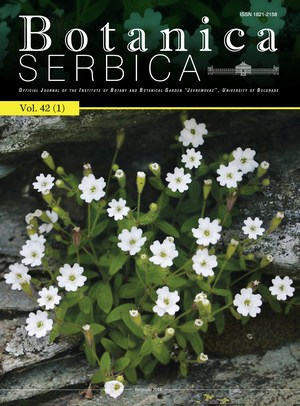
Volume 42 Issue 1 2018 |
Editorial
|
Towards an Excursion Flora for Austria and all the Eastern Alps
|
KEY WORDS: flora, Alps, chorotypes, endemism, identification keys, Vienna diacritical method, vegetation |
Recent progress in floristic and taxonomic studies in Bulgaria
|
KEY WORDS: Bulgaria, flora, literature, vascular plants |
Distribution and variability of the Balkan endemic Geum bulgaricum (Rosaceae) - a species of European concern
|
KEY WORDS: Balkan Peninsula, endangered species, genome size, Geum, lectotype, morphology |
Beech forests (order Fagetalia sylvaticae Pawlowski 1928) in Serbia
|
KEY WORDS: altitudinal gradient, alpha diversity, beech (Fagus sylvatica) forests, canonical correspondence analysis, K-means clustering, species richness |
Rediscovery of the endemic species Chara rohlenae Vilh. 1912 (Characeae) - believed extinct - on the Balkan Peninsula
|
KEY WORDS: Charophyta, new records, endemic species, Chara rohlenae |
Ornithogalum insulare (Hyacinthaceae): A new species from the Cretan area (S. Aegean, Greece)
|
KEY WORDS: Ornithogalum subg. Beryllis, Aegean flora, chromosome number, conservation, new species |
The first record of Ephedra distachya L. (Ephedraceae, Gnetophyta) in Serbia - Biogeography, coenology, and conservation -
|
KEY WORDS: Ephedra distachya, Ephedraceae, new record, Stara Planina Mountains, flora of Serbia |
Four neophytes new for the flora of Bosnia and Herzegovina
|
KEY WORDS: alien flora, Balkans, Juncus dudleyi, Hypericum majus, Sisyrinchium montanum, Symphyotrichum lanceolatum |
Ranunculus aconitifolius L. (Ranunculaceae), a taxon new for the flora of Serbia
|
KEY WORDS: Ranunculus aconitifolius, first record, Mt. Željin, Serbia |
List of reviewers for Botanica Serbica in 2017 — Acknowledgements
|


